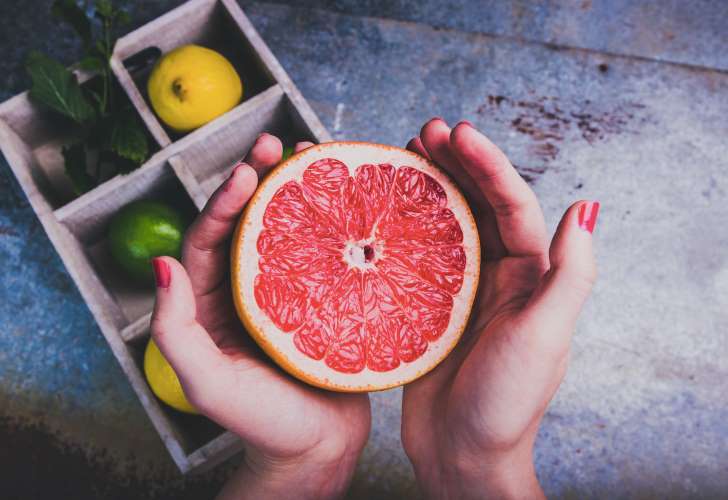Desperate to break off your long-term love-hate relationship with sugar? We know the feeling. In just a few hours (read: the time it takes to finish a carton of Ben & Jerry’s), we’re wheeled through sugar highs, sugar comas, unexpected hanger, and desperate longing—and yet, we always end up welcoming glucose, fructose, and sucrose back into our lives with open hearts/mouths.
So if you’re ready to step off of the emotional (and physical) rollercoaster, you’ve come to the right place. These 10 tips from wellness expert, author, and nutrition consultant Kelly LeVeque of Be Well by Kelly will help you build a foolproof plan for cutting down on sugar and staying strong through those tough moments when all you want is cookie dough.
1. Replace it, neutralize it, and break it… for good!
Soda might not be your thing. Maybe it’s frozen yogurt, Hot Tamales, or gum. Whatever it is, you know it needs to stop. If you’re not a quit-cold-turkey type of person, try to replace the habit as often as possible with a cleaner option you are less emotionally attached to. Maybe swap for a flavored sparkling water or fruit-infused water first. Gradually replacing means you’re gradually neutralizing. The goal is to break the habit once and for all. It’s much easier to do that when its power has been sapped time and again, instead of trying to do it month after month.
2. Get to know your labels.
The nutrition label lists all ingredients in order of quantity. The higher up on the list, the more prevalent the ingredient. A good rule is to avoid products that contain sugar in the first three ingredients.
3. Learn how to spot sneaky sugars.
Sugar is often a hidden ingredient in processed foods, but a good rule is to look for words that end in “ose” like sucrose, maltose, dextrose, fructose, glucose, galactose, lactose, high-fructose corn syrup, glucose solids.
4. Keep your blood sugar in check.
Sugar on a nutrition label only identifies “added sugar”—it doesn’t explain how the food will affect your blood sugar. It’s important to understand how a food will affect your blood sugar because crashing blood sugar creates insatiable cravings for more sugar. You can calculate net carbohydrates by subtracting fiber from total carbohydrates. Aim to choose food high in fiber to keep blood sugar balanced and add fat or protein to meals that contain more than 25 net carbohydrates to help support your body’s blood sugar balance.
5. Get your a.m. protein.
Start your day with protein! Eating protein can help lower NPY (neuropeptide Y), a hormone produced in the brain and nervous system that “stimulates” the appetite for carbohydrates and sugar.
6. Stop drinking sugar.
One of the easiest ways to lower sugar intake is to eliminate liquid sugar. Avoid soda, juice, sweetened coffees, and sugar-laden libations, and instead, choose to flavor your water with strawberries or cucumbers, sweeten black coffee with a sugar and chemical-free sweetener like stevia, and opt for low-sugar bevs like pinot noir.
7. Instead… drink more water.
Wake up and drink two large glasses of water to help flush out your system and lower blood glucose levels. It’s especially important if you have been drinking alcohol and might be dehydrated. When you’re dehydrated, the volume of blood decreases, and the blood glucose remains the same, meaning you have more concentrated blood sugar. Drinking water (10 glasses a day) can increase blood volume and decrease glucose concentration.
8. Sweet things come in small packages. And big ones too.
Check every food with a label. You will find hidden sugar everywhere from bread, tomato sauce, ketchup, and canned food to kombucha, cold-pressed juice, and chia seed pudding. Just because it looks like a healthy food doesn’t mean it is one. A good rule of thumb is to eat real, whole food meals and do your best to avoid snacking on packaged snacks because they tend to have the highest sugar servings.
9. Focus on the Fab Four.
The Fab Four (protein, fat, fiber, and greens) is a light structure I built to help my clients remember what nourishing foods they should eat to elongate their blood-sugar curve (to have the energy and fuel to easily move toward ditching snacks), and support hormone production, microbiome proliferation, and healthy body composition.
Eating the Fab Four calms various hunger-related hormones. Protein, fat, and fiber induce cholecystokinin (CCK, a “satiety hormone”); protein and leafy green vegetables increase glucagon-like peptide-1 (GLP-1, the “full hormone”), and a fiber- and protein-based meal increases concentrations of peptide YY (PYY – “control hormone”), which all reduce appetite.
10. Go to bed!
You aren’t immune to the consequences of a disruption to your circadian system and shorter sleep cycles; it doesn’t matter if you are in college, work out like crazy, or try to make up for it over the weekend. The next time you’re binging your next favorite Netflix show, remember the results of this 2017 study: “Later sleep time was associated with higher estimated insulin resistance across all groups.”
And this 2008 meta-analysis featured 634,511 participants from around the world (with ages ranging from 2 to 102 years old and included boys, girls, men, and women) and proved “an increased risk of obesity among short sleepers along with an increase in appetite and caloric intake associated to reciprocal changes in leptin and ghrelin.” That extra hour of TV just lowered your insulin sensitivity, which will keep circulating glucose higher, increase your hunger and cravings for sugar, and potentially set you up for weight gain.












